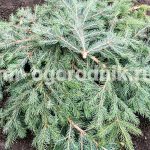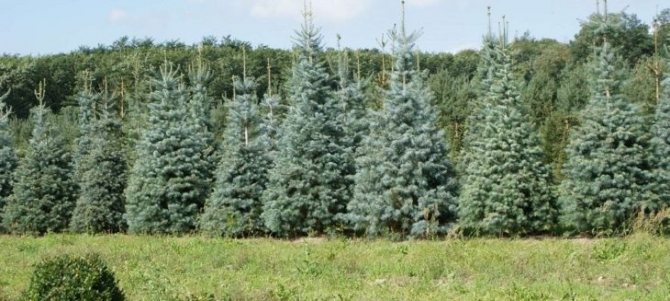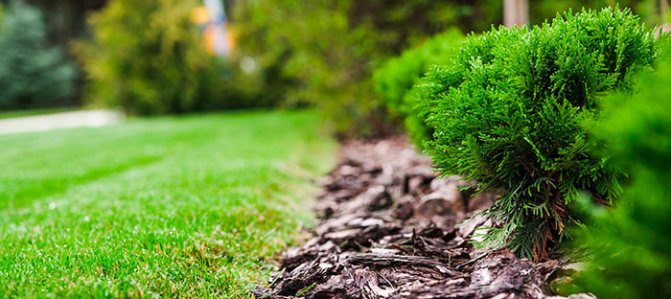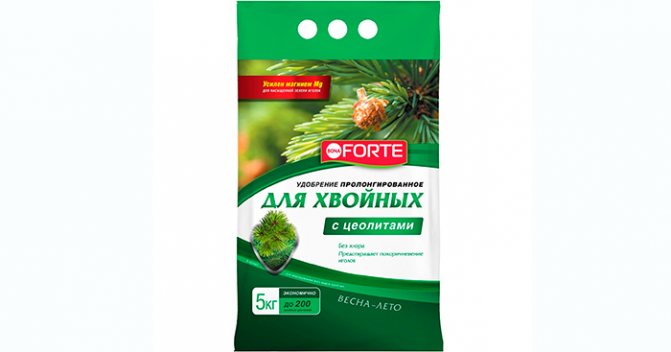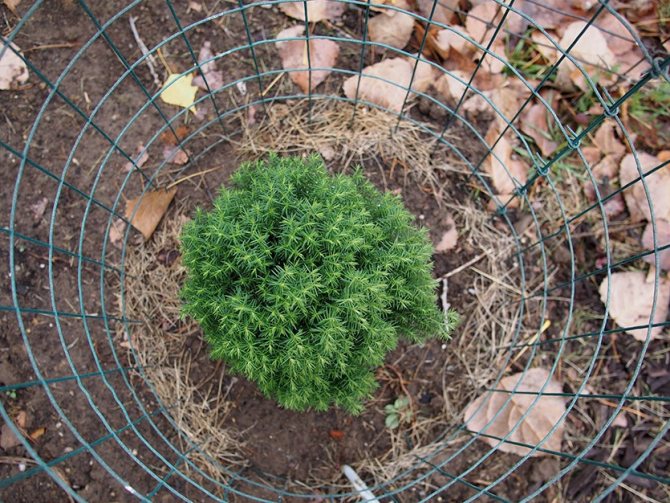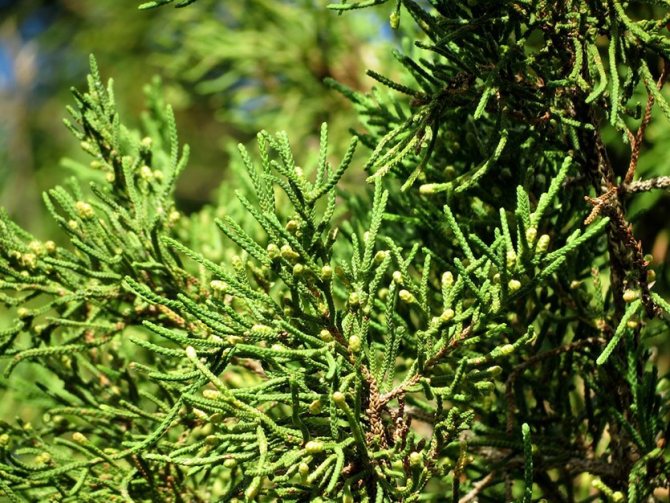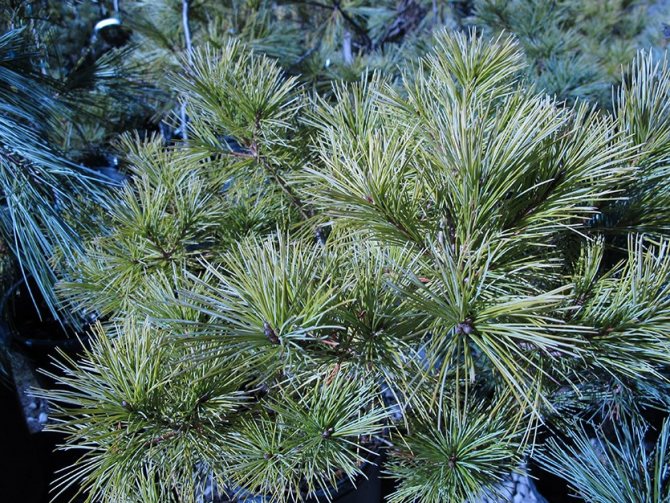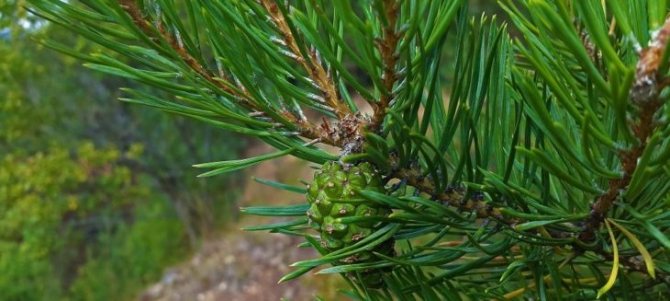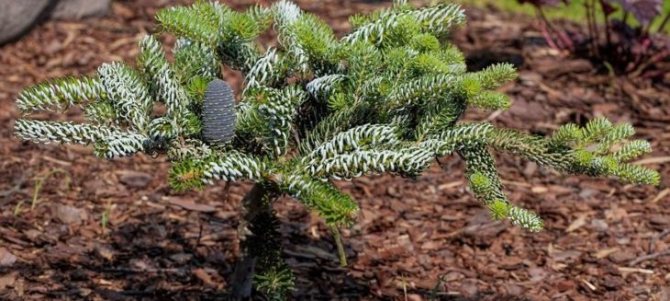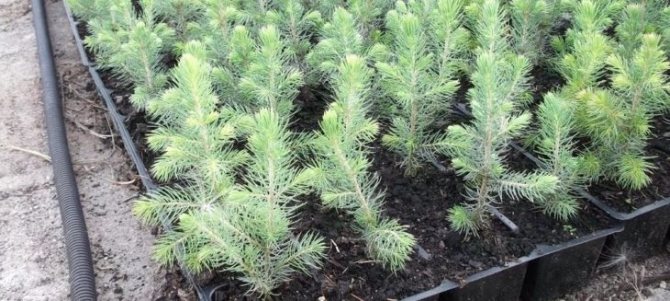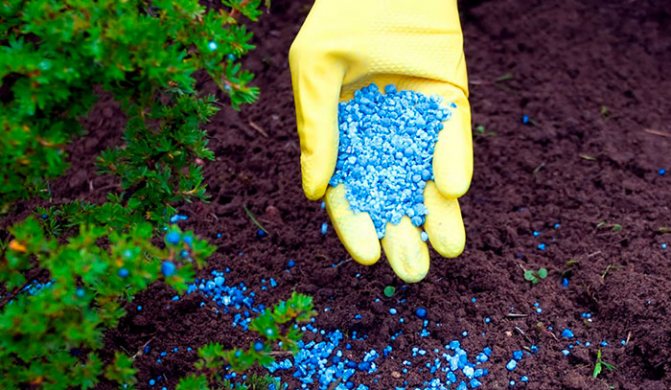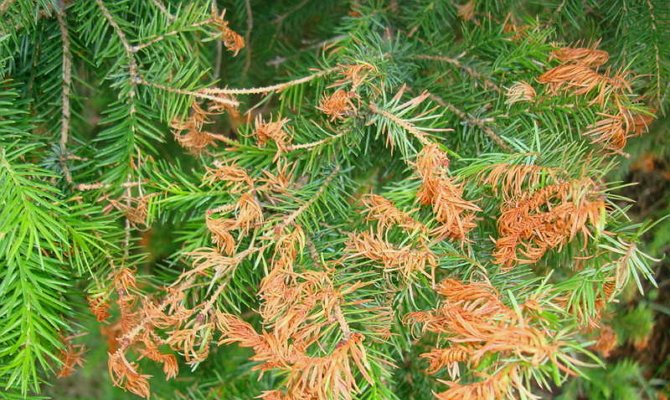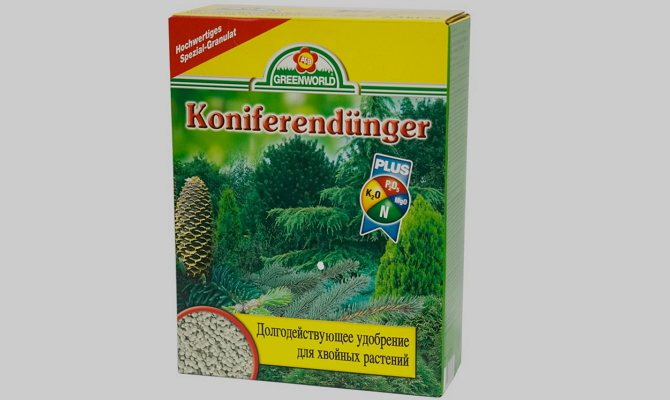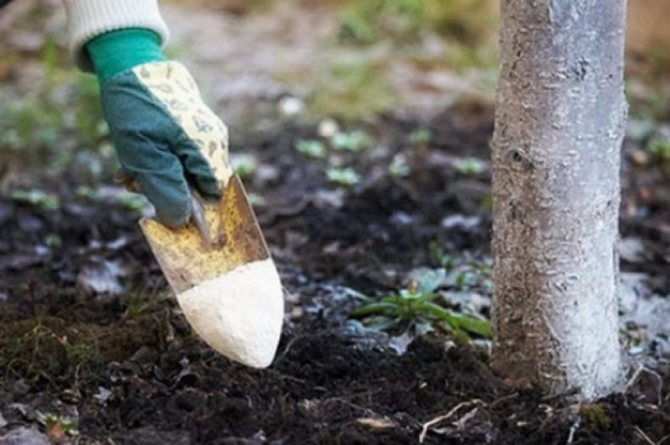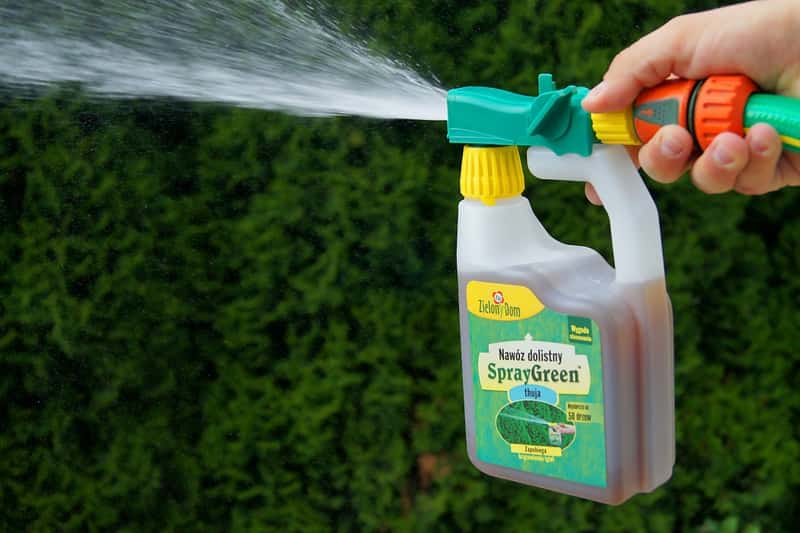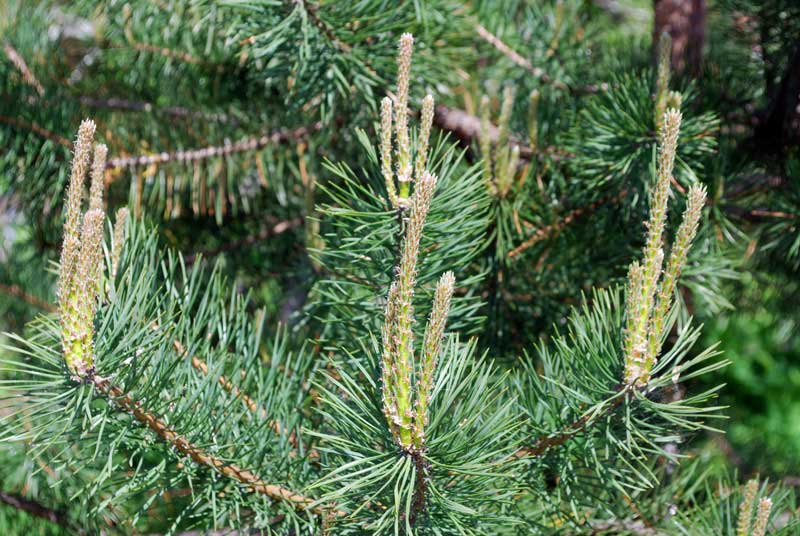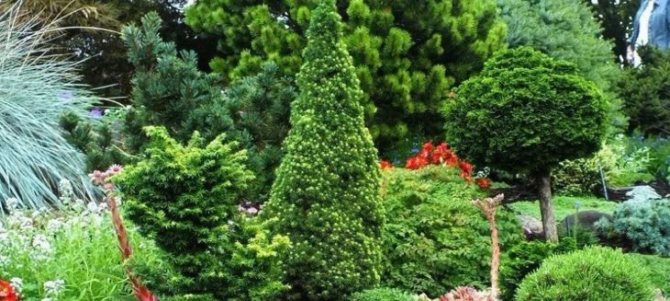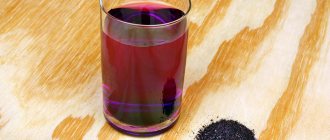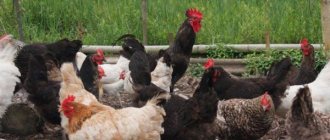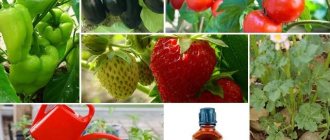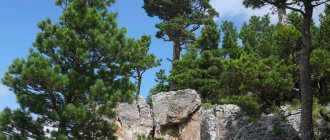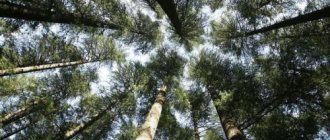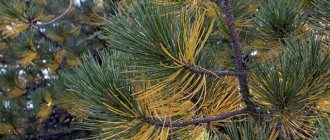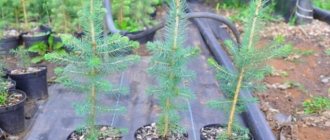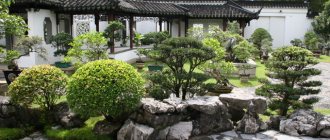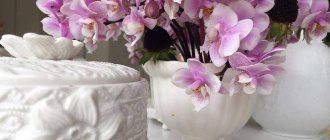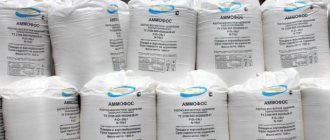When a plant needs feeding
Coniferous beauties do not shed their leaves in the fall, therefore they retain within themselves all the useful substances in them. In winter, the movement of fluid inside only slows down, and in spring it resumes again. And all the same, according to existing canons, young individuals need feeding for the first ten years. The same applies to cases when an evergreen plant was transplanted from one place to another in the garden. After this period, fertilizers are applied only to the soil that is poor in nutrients and trace elements important for conifers.
At the same time, if signs of deterioration in the condition of a coniferous plant are noticed, you need to try to help him restore his health. These signs include:
- slow growth of the trunk in diameter;
- slow growth in height;
- the rarity of the branches;
- pallor of the needles, their yellowing and drying;
- hyper-release of resin;
- poor survival rate of seedlings.
Shelter for the winter
Protected from coniferous needles or sawdust, plant roots are well protected from overheating in summer and hypothermia in winter. Temperature differences between cold September nights and still warm days are smoothed out, and the plant has the opportunity to prepare for winter.
Rodents do not like to hibernate in coniferous shelters.
- Covering grapes, anemones, clematis and other thermophilic vines are removed from the trellises and laid on the ground.
- The branches of rhododendrons, azaleas, roses, thermophilic berries can be pinned to the ground.
- Similarly, you can insulate bulbous flowers and beds with winter crops.
The needles for winter shelter can be used after preliminary drying in the sun. The above-ground part of the plants is poured to the top, then covered with a thick film and its edges are fixed with stones or earth.
The film will keep the mulch dry and help prevent fading during thaw periods.
How to insulate the root system of young seedlings: lay out dense bags filled with dry needles in close circles.
Coniferous branches cover biennials and perennials, especially those that suffer from drought in spring (ferns, heuchera).
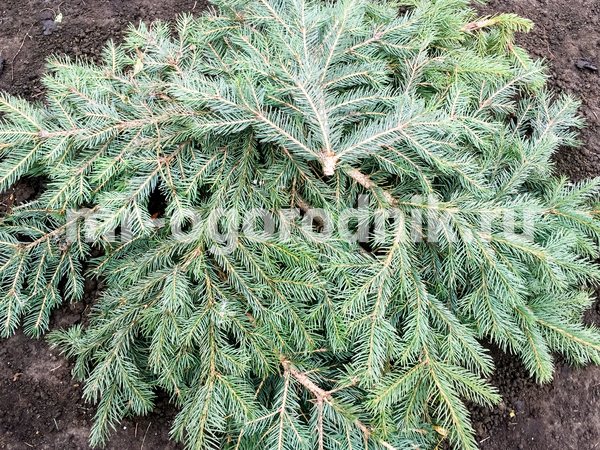
Some gardeners advise protecting young trees from rodents with pine spruce branches in winter. To do this, branches are tied to the trunks with needles down.
What are the features of feeding
The optimal time for feeding is early spring. As soon as the snow cover melts, it is time for such an event. Coniferous tree feeding has a number of differences from, for example, fruit trees. The main one is the need for potassium and magnesium and the uselessness of nitrogen. Therefore, manure, as the main supplier of nitrogen, is unacceptable. It will harm both adult trees and young ones. Being a growth stimulant for a plant, its compositions accelerate the appearance of late shoots, which will not be able to get stronger before the onset of cold weather. Some of them die, and those that survive will take the plant's strength for their recovery in the spring.
However, there are complex preparations designed specifically for feeding conifers. They can be used boldly, following the instructions for use exactly. In general, the fertilizers used can be divided into three groups: mineral, organic, complex.
The most suitable are vermicompost and compost.
- Fertilization of plants with liquid biohumus to increase the yield and decorative properties.
- How to make healthy nutritious compost at home.
- How to make the right compost and not confuse it with humus.
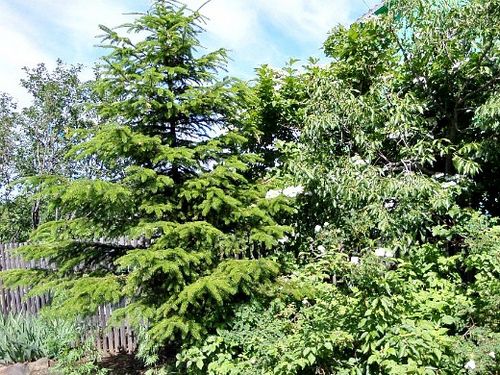

When selecting means for feeding evergreen trees and bushes, it is necessary to take into account the acidity of the soil. So, most of the plants are "friendly" with the root system of the soil fungus mycorrhiza. It helps to improve the absorption capacity of the roots. Since an acidic environment is optimal for mycorrhiza, trees have also adapted to it.
However, some species are an exception to this rule, for example, juniper, berry yew, black pine. They are adherents of alkaline soils.
Knowing such features, on your site you can create areas with different types of soil, and use granular fertilizers to feed the plants on them. Granules should have a high calcium content, with the participation of which the needles acquire a green color, do not turn yellow and do not fall off.
Pest control
The smell of conifers scares off pests: the needles contain terpenes, they help in the fight against parasites, snails and slugs (the best way to protect the plant from them is to sprinkle needles around it).
From wireworm can be added to the holes when planting potatoes with a handful of coniferous needles.
Coniferous infusion
Coniferous infusion can be sprayed on plants from pests in the spring:
- needles, or better chopped young pine twigs (they contain many times more ether) - 1-1.5 kg.
To obtain a mother liquor, the needles are poured into a bucket and poured with hot water. Insist 3-4 days, stirring sometimes.
Then the infusion is diluted 2 times with clean water, a couple of tablespoons of liquid soap is added and trees and shrubs are sprayed.
The treatment is carried out several times, starting with the swelling of the buds and until the end of flowering.
What helps:
- apple moth, flower beetle, honeydew, leafworm,
- various types of aphids on horticultural and horticultural crops.
For processing vegetable crops, dilute the infusion with water 1: 2.
Now read:
- Rabbit manure as a fertilizer for the garden and vegetable garden
- How to prepare an ash infusion for feeding and ...
- How to treat cabbage from pests
- Proper care of strawberries in spring
- How to feed dahlias throughout the season
Coniferous broth
- 1.5 - 2 kg of raw materials,
- 6 liters of water.
The needles are boiled over low heat for 15-20 minutes, then left to cool and filtered. For spraying, 8 liters of water and 2 tablespoons of liquid soap are added to 2 liters of broth.
The broth can be used to process vegetable beds every 1.5-2 weeks after planting seedlings in the ground. Will help from caterpillars, cruciferous flea.
From Colorado potato beetle a more concentrated working infusion is needed - 4 liters of broth for 6 liters of water.
Treatment of beds before planting
- 4-5 st. l. thuja, fir or pine needles,
- 1 liter of boiling water.
Insist on the composition for 3-4 days. Then the mother liquor is prepared: 2 tbsp. l. pine extract and 1 liter of ash broth are diluted in 10 liters of water and 100 g of green soap is added. The composition is diluted with water (1: 5), filtered and the beds are spilled on the eve of sowing or planting.
From fungal diseases
Plants can be treated with coniferous infusion (in a ratio of 1: 2 to water) every 1.5 - 2 weeks. According to gardeners, after such treatments, tomatoes are less likely to be affected by late blight (only in very unfavorable weather), cucumbers and zucchini are less susceptible to powdery mildew.
Mineral fertilizers
Dolomite flour has proven itself well as mineral additives. This substance contains magnesium, and it is he who is important for the correct process of photosynthesis. To fertilize the soil under one tree or shrub, you will need 0.5-1 kg of the composition.
Dolomite flour.
You should be careful with the introduction of mineral fertilizers: an excess of minerals can negatively affect the growth and development of conifers or even destroy them. For the same reason, urea should not be used.
Having picked up mineral fertilizers, soluble in water, you can apply them to the garden ground every day, including from June to August. When the primary liquid formulation is diluted in a large amount of water, the concentration of the active components in the solution becomes negligible, which is ideal for dwarf varieties. For the same reason, it is recommended to water the plant more often at the time of fertilization.
Needles of pine and spruce
Larch needles are effective fertilizers. Certain types of needles are used in the fight against diseases and pests. Needles can be fruitfully used for the following purposes:
- Fighting snails, slugs. It is used without complicated preparations - the plant is surrounded by a large number of needles, a "fur coat" of needles is made around it. Terpenes frighten pests.
- Needles are used as fertilizer. Suitable for crops grown in acidic soil to increase the indicator.
- For mulching. For a normal effect, a huge number of needles must be used.
- Used as a support for strawberries or strawberries. If the berries are raised higher, the bushes will grow more actively, in the end it is better to bear fruit. The attacks of the bear and other insects moving underground are significantly reduced.
- For early decay of other fertilizers. Covering the leaves with the foliage of the needles, which are later used as fertilizer, they will not scatter so much. The moisture will be stored in the compost better and the rotting will increase.
- As an insect control agent. You can prepare a solution by insisting on water and use it neat or diluted. Many plant diseases subside after using the prepared liquid. Various areas of crops are sprayed. Strong infusion is sometimes dangerous for plants, it is recommended to either dilute it with water, or use it only between rows, without direct application to the crop.
- For repelling insects. Having a specific smell, the needles drive away pests.
Organic fertilizers
Experts also advise against rushing with natural organic fertilizers. The nitrogen they contain can damage the root system. Therefore, only a limited amount of vermicompost is allowed as organic matter. It is able to retain beneficial bacteria than to raise the plant's immunity to diseases.
In spring loosening, composting is allowed. In this case, digging is carried out to a depth of about 3 cm, and the fertilizer is carefully mixed with the soil.
For the beginning of the growing season, it is recommended to fertilize the coniferous crop with humus.
What is humus, what benefits does it bring and what it consists of.
Needles for mulching
Does coniferous litter acidify the soil? The acidity of rainwater is 5.6. The acidity of pine needles is 6.0. However, some soils have a pH below 6.0. So the use of needles of coniferous plants for mulching plantings, even with a layer of 7.5 cm, does not lead to a change in the acidity of the soil!
It is good to mulch "sour lovers" with litter:
It is better to use rotten needles. The layer of summer mulch should be thin enough (up to 5 cm). You don't need to bury anything in the soil, all processes take place on its surface.
Mulch can also be made flaky, by analogy with a compost heap in the following sequence: weeds without seeds + rotted manure + coniferous litter. Its thickness on clay soils should be at least 10 cm, on sandy soils - up to 15 cm. For a while, the mulch is covered with a film, it is removed for the winter.
The needles on the surface of the soil rot very slowly. Therefore, in the fall, after harvesting, it is removed from the beds and sent to the compost heap.
If you mulch trees with needles, you do not need to remove it for the winter - move the mulch aside, close up fertilizers and deoxidizers with a hoe in the near-trunk circle and return the litter to its place.
Video recommendations for mulching needles
Ivan Russkikh talks about the peculiarities of the styler and its use on the site.
Video: does litter acidify the soil?
Complex composition
Separate self-introduction of organic and mineral additives is troublesome and requires special care for conifers. Therefore, special outlets offer industrial products with a balanced composition and recommended for specific purposes. So, in the spring, you can add "Fertile universal for conifers", "Fertika-lux", "Khvoinka", "Zdraven turbo for conifers" into the soil for seedlings. They have selected the optimal ratio of organic matter and minerals for young conifers.
The positive experience of using the Greenworld complex remedy, a substance in which the magnesium content is increased, has been noted. As a result of its application, the growth of plants is intensified, the brightness of the color of the needles is acquired, the plant becomes resistant to changes in air temperatures and precipitation. If fertilized in this way, drought and rainy weather conditions are easier for conifers. The recommended frequency of introduction is 2-3 times a season.
Complex fertilizers may contain additional useful chemical elements. Most often these are:
- phosphorus;
- potassium;
- magnesium;
- iron;
- sulfur;
- boron
Boric acid in the garden.
Iron deficiency will lead to the development of chlorosis (a condition where the needles lose their brightness and gradually turn yellow). If there is not enough sulfur in the soil, the needles do not ripen and become small. In the case of an insufficient concentration of boron, plants lose their resistance to cold and can suffer from a sharp change in temperature.
Care for conifers in autumn
Few in any garden do not grow conifers. These colorful plants sometimes play a key role in garden design, so it is important that they look healthy. Conifers are mostly unpretentious, and knowing this, you can forget about the conditions of detention they need. This is fraught with yellowing of the needles, sometimes so strong that you have to cut out the branches or completely remove the plant.
Winters are especially dangerous for many conifers, after which new yellow branches can be found. Therefore, it is in the fall that we have a chance to create all the conditions in order to see a healthy green plant in the spring.
The main elements of caring for conifers in the garden in autumn
By the beginning of September, it is necessary to stop fertilizing for conifers. These plants require less feeding than deciduous ones, since they do not expend energy on restoring green mass. In spring and summer, you can use Fertika fertilizers for conifers.
But the roots of conifers need support in order to get through the winter well. This applies to both young plants and adults (especially young ones). Therefore, do not forget to apply Epin at the beginning of autumn.
Fungal diseases are not limited to fruit trees. Conifers are also susceptible to them. In the fall, in September or October, pick up a dry, calm day and treat the conifers with a fungicide. It is better to do this in the morning or in the evening. Of the preparations, Aktara, Topaz, Horus, Hom are suitable. You can combine the processing of conifers with the autumn processing of the entire garden.
Moisture-charging watering of conifers
And the most important component of the health of your needle-like inhabitant is water-charging watering in the fall. It is necessary in order to fully saturate the plant with water. During the first thaws in spring, when the sun warms up brightly, the lush needles will strongly evaporate moisture into the air.Deciduous branches are bare and the evaporation area is much smaller, and therefore they do not suffer from thaws so much. We can help conifers and make a good supply of water in the fall.
Moisture-charging watering is done in October or November, until frosts come and the warm weather has already ended. It can be avoided if the fall is very rainy. If there is not much or no rain at all, then it is highly recommended to shed the plants well. It often seems to us that there is rain and it has saturated the ground perfectly, but conifers have a very dense crown, and it, like an umbrella, protects the near-stem space from moisture.
To create a strategic water supply, water the plants abundantly. The approximate volume of water that is recommended to be applied under the culture is about 3-6 lei, depending on the size of your pet.
Closer to winter, it is worth considering shelter for some species of conifers. The hot spring sun can cause burns on the crown, so the plants are tied with a special non-woven material. Only it will be important to remove it in time, so that under it, as under a hood, with the onset of heat, the branches do not vomit.
Pyramidal varieties of conifers, especially thujas, can be damaged by heavy snowfalls. Heavy wet drifts on branches are especially dangerous. So that they do not damage the plant, it is tied several times with dense twine, pressing the branches to the trunk.
No special cropping is required here. It is only needed if you decide to limit its growth, or as a last resort to eliminate yellowed branches.
If, nevertheless, the plant overwintered badly and turned yellow, we described in detail how to help your evergreen friend in this article.
This is probably all that is required for your coniferous neighbors to feel good and survive the winter without any problems.
The benefits of vermicompost
Vermicompost is used in liquid form for root feeding of conifers. It is diluted with water according to the instructions and the plants are watered with it. Vermicompost is good because it contains biological compounds available for plants and beneficial microorganisms.
When it is introduced into the soil, its fertility increases significantly, and the plants receive all the nutrients they need. Conifers become more hardy, their resistance to diseases and other unfavorable factors increases.
Vermicompost is watered on the trunks of coniferous plants

